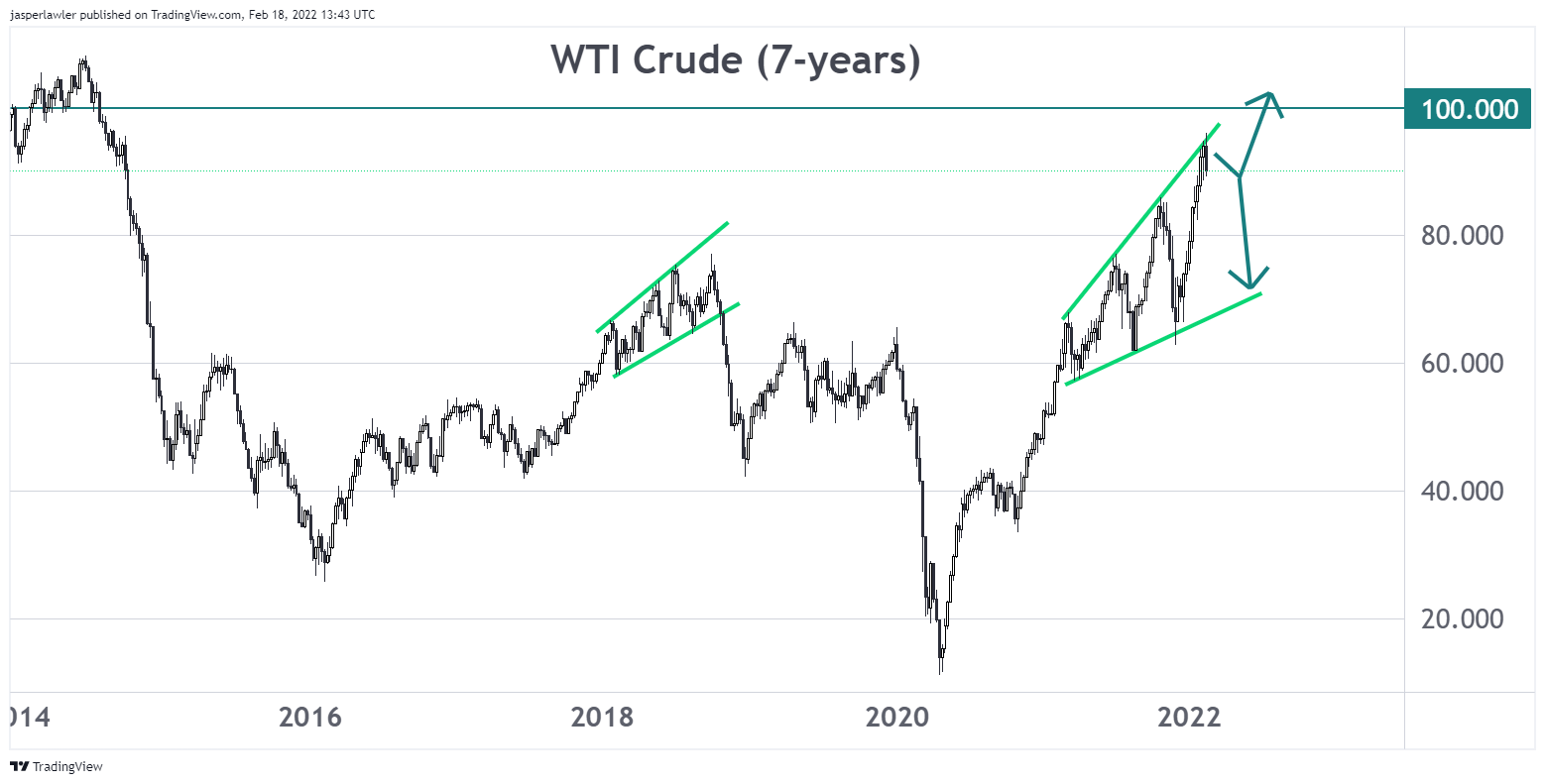Oil prices have booked gains for eight straight weeks amid heightened geopolitical risk but this week could be the first weekly decline since mid-December, possibly opening the door to a deeper pullback.
The story with oil
Geopolitical tensions remain high between Russia and Ukraine, which is a crucial transit hub for gas coming from Russia to Europe. European gas prices have skyrocketed – in part owing to Europe’s reliance on Russian gas - bringing the whole energy complex with them.
At the same time, many economies have returned to pre-pandemic levels of economic activity, while OPEC+ which includes Russia have only cautiously raised output quotas to meet the demand.
What’s happening to the oil price?
Oil is pausing for breath at $95 per barrel. It follows a sharp move higher over 2-months from under $63 in December. The last time WTI crude reached over $90 was in late 2015.
The price of oil continues to print to new higher highs, confirming the uptrend that has been in place for nearly two years. The upwards trend is reason to think oil can reach $100 per barrel. However, there is some loss of momentum as the trend has matured, which can be seen in a rising wedge pattern, which tends to resolve lower, as happened in 2018.

Source: TradingView @jasperlawler
Does it all depend on Russia?
Both Russia and Ukraine are key players in the energy market. Russia is a principal supplier of energy to Europe and Ukraine is a crucial hub in the path of transporting Russian oil and gas to Europe.
The impact of a Russian invasion in the oil market could be two-fold.
- Firstly, energy supply could be disrupted due to conflict in Ukraine or because Russia decides to slow supply, driving up oil and gas prices.
- Secondly, the West could impose sanctions on Russian oil, which would limit supply in an already very tight market.
Europe will be keen for other sanctions to be imposed rather than sections on oil, given that it could be likened to shooting itself in the foot. Higher oil prices, lifting inflation higher could hit the eurozone’s growth prospects.
Oil prices have seesawed as the risk of Russia invading Ukraine has increased or receded, rising to a fresh 7 year high as fears spiked, before easing back and being overshadowed by US-Iran negotiations.
With talks between US secretary of state Anthony Blinken and Russia’s foreign minister Sergey Lavrov set for Tuesday (Feb 22), concerns of an imminent invasion have cooled on Friday, helping oil prices lower.
That said, should Russia invade, oil prices could rapidly hit $100 per barrel and beyond. Whilst eastern European tensions are a key driver of oil prices, they are not the only driver.
US – Iran nuclear talks
The oil markets have been eyeing US – Iran nuclear talks for a while now. Progress has been in fits and starts. However, a breakthrough to revive the 2015 nuclear deal appears to be moving firmly in the right direction this week. Comments from Iran’s top nuclear negotiator Bagheri signalling that the two sides were closer than ever to a deal pulled the price of oil sharply lower. France also commented that a deal was just days away.
The revival of this deal is likely to set in motion a series of events that would see sanctions on Iranian oil removed. This would mean that an estimated 900,000 additional barrels per day of oil could come flooding back to the market as production ramps up, making a significant contribution to easing the tight supply which is currently defining the market.
In fact, this would cover 90% of the International Energy Association’s additional supply request. The IEA said that it wants OPEC+ to produce an additional 1 million barrels per day to cool oil prices and reduce elevated levels of volatility in the oil market.
However, the US – Iran deal is by no means signed sealed and delivered. We have been here before, only for progress in talks to slow significantly or stop. Doubts remain over whether Iran would take the political decision to ink a deal with the West. If they did, it would certainly relieve some of the tightness which has been building in the market over the past few months.
Demand
Demand for oil has been on the rise as the global economy recovers from the pandemic. In its latest report OPEC said that, given global GDP is already reaching pre-pandemic levels, it expects global oil demand to increase by 4.15 million bpd. Consumption is expected to exceed 100 million bpd in the third quarter of this year, a level of use last seen in 2019.
Oil inventory data had regularly highlighted strong demand compared to limited supply with stockpiles falling. Inventories at the key Cushing hub dropped to their lowest level since 2018.
OPEC+
Yet despite roaring demand and oil prices surpassing their pre-Covid highs, OPEC production remains well below its pre-pandemic level. OPEC+ has failed to meet its upwardly revised production quotas over the past few months.
OPEC+ agreed to increase production by 400,000 bpd a month yet output in January increased by rather tame 64,000 bpd. Seven of the thirteen OPEC+ countries, rather than increasing output, actually saw production decline, owing to a lack of spare capacity and under-investment, a situation reminiscent of that in 2007/8 when oil prices were pushed at $147.
OPEC+ has been resisting pressure from the top oil importers to ramp up production further. Although how useful this would actually be when current quotas aren’t being met is questionable.
Backwardation
Backwardation has been playing out in the market This is where the front month is more expensive than the following contract. It means that the market is willing to pay more for immediate delivery rather than having to wait and suggests that cooling of demand is unlikely in the near term.
Summary
Oil prices have risen by 19% so far this year. Demand has ramped up as economies have re-opened and supply has been limited as OPEC+ fails to reach its upwardly revised quota. Fears of Russian invading Ukraine have boosted oil prices to the highest level in 7 years and a full-on invasion, if it were to occur, is likely to see oil prices rise quickly to $100 per barrel.
However, the revival of the US – Iran nuclear deal could see Iranian oil come flooding back to the market, alleviating tight supply and pulling oil prices away from $100.





